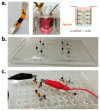Impedance-Based Monitoring of Mesenchymal Stromal Cell Three-Dimensional Proliferation Using Aerosol Jet Printed Sensors: A Tissue Engineering Application
- PMID: 32413993
- PMCID: PMC7287852
- DOI: 10.3390/ma13102231
Impedance-Based Monitoring of Mesenchymal Stromal Cell Three-Dimensional Proliferation Using Aerosol Jet Printed Sensors: A Tissue Engineering Application
Abstract
One of the main hurdles to improving scaffolds for regenerative medicine is the development of non-invasive methods to monitor cell proliferation within three-dimensional environments. Recently, an electrical impedance-based approach has been identified as promising for three-dimensional proliferation assays. A low-cost impedance-based solution, easily integrable with multi-well plates, is here presented. Sensors were developed using biocompatible carbon-based ink on foldable polyimide substrates by means of a novel aerosol jet printing technique. The setup was tested to monitor the proliferation of human mesenchymal stromal cells into previously validated gelatin-chitosan hybrid hydrogel scaffolds. Reliability of the methodology was assessed comparing variations of the electrical impedance parameters with the outcomes of enzymatic proliferation assay. Results obtained showed a magnitude increase and a phase angle decrease at 4 kHz (maximum of 2.5 kΩ and -9 degrees) and an exponential increase of the modeled resistance and capacitance components due to the cell proliferation (maximum of 1.5 kΩ and 200 nF). A statistically significant relationship with enzymatic assay outcomes could be detected for both phase angle and electric model parameters. Overall, these findings support the potentiality of this non-invasive approach for continuous monitoring of scaffold-based cultures, being also promising in the perspective of optimizing the scaffold-culture system.
Keywords: 3D monitoring; aerosol jet printing; impedance-based cell spectroscopy; mesenchymal stromal cells; tissue engineering.
Conflict of interest statement
The authors declare no conflicts of interest.
Figures









References
-
- Dominici M., Le Blanc K., Mueller I., Slaper-Cortenbach I., Marini F., Krause D., Deans R., Keating A., Prockop D., Horwitz E. Minimal criteria for defining multipotent mesenchymal stromal cells. The International Society for Cellular Therapy position statement. Cytotherapy. 2006;8:315–317. doi: 10.1080/14653240600855905. - DOI - PubMed

